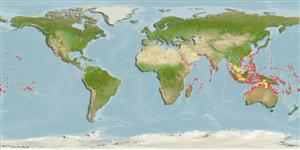>
Eupercaria/misc (Various families in series Eupercaria) >
Labridae (Wrasses) > Corinae
Etymology: Thalassoma: Greek, thalassa = the sea + Greek, soma = body; the colour of the sea (Ref. 45335).
More on authors: Lay & Bennett.
Environment: milieu / climate zone / depth range / distribution range
Ecologia
marinhas associadas(os) a recifes; intervalo de profundidade 0 - 40 m (Ref. 2334), usually 1 - 5 m (Ref. 90102). Tropical; 30°N - 32°S
Indo-Pacific: East Africa to the Hawaiian, Marquesan, and Tuamoto islands, north to the Ryukyu Islands. Replaced by Thalassoma cupido from southern Japan to Taiwan, Thalassoma heiseri in Pitcairn, and Thalassoma loxum at Oman (Ref. 37816). Reported hybrids with Thalassoma jansenii in Banda Sea, Indonesia and with Thalassoma nigrofasciatum in Holmes Reef, Coral Sea (Ref. 57554).
Tamanho / Peso / Idade
Maturity: Lm ? range ? - ? cm
Max length : 17.0 cm TL macho/indeterminado; (Ref. 4392)
Espinhos dorsais (total): 8; Raios dorsais moles (total): 12-14; Espinhos anais 3; Raios anais moles: 10 - 12. Males display with brilliant colors, red lines turning purple and often the abdomen bright yellow (Ref. 48636). Two uneven red stripes on dorsal half of body, 1 from below dorsal-fin origin onto upper caudal lobe, the other from above pectoral-fin base to caudal peduncle. Pectoral fins with green base and dark pectoral fins (Ref 9823).
Found in clear outer lagoon reefs (Ref. 9710) and exposed seaward reefs. Abundant in shallow exposed areas with surge channels (Ref. 9710, 48636), with gutters, large Acropora plates and algae bottom (Ref. 48636). Benthopelagic (Ref. 58302). Males are often in small loose numbers, swimming over reef sections where small groups of females stay close to the bottom. Juveniles secretive in shallow gutters (Ref. 48636). Feed mainly on benthic crustaceans (crabs, shrimps), small fishes, gastropod mollusks, and sea urchins.
Life cycle and mating behavior
Maturidade | Reprodução | Desova | Ovos | Fecundidade | Larvas
Pelagic spawner.
Randall, J.E., G.R. Allen and R.C. Steene, 1990. Fishes of the Great Barrier Reef and Coral Sea. University of Hawaii Press, Honolulu, Hawaii. 506 p. (Ref. 2334)
Categoria na Lista Vermelha da IUCN (Ref. 130435)
Warning: mysqli::__construct(): (HY000/1040): Too many connections in /var/www/html/includes/func_getlabel.php on line 46
Can't connect to MySQL database (fbapp). Errorcode: Too many connections
